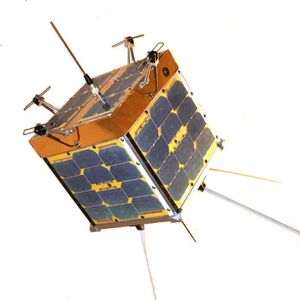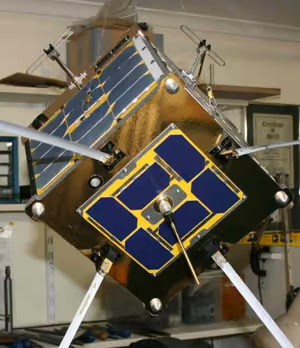KiwiSAT

An Amateur Radio Contribution to Climate Change Research
KiwiSAT Ionospheric Research Project
Overview
Various satellite companies are investigating the use of satellite borne radar systems to track such climate change parameters as
Biomass assessment, Forest inundation, Ice sheet thickness measurement and subsurface moisture levels.
The most suitable frequencies for these radar systems are in the 400MHz region.
Improving the measurement accuracy requires a thorough understanding of the characteristics of the applicable portion of the
ionosphere at these frequencies. Currently few satellites carry transmitters producing suitable signals for this research, and even fewer
that are in suitable orbits.
The ionospheric characteristics that require investigation are Total Electron Content (TEC) and Faraday Rotation.

70 cm Beacon Antenna.
During the construction phase of KiwiSAT the engineering team was approached by EADS Astrium* on behalf of Professor Cathryn
Mitchell, University of Bath, seeking inclusion of a special beacon to provide a compatible signal for this ionospheric research.
A 470MHz phase-coherent beacon was quickly designed and integrated into KiwiSAT to accommodate this request.
Dual Beacon Experiment
To investigate these signal path characteristics, KiwiSAT will transmit two identical, phase locked, signals, one at 145.865 MHz with 1
Watt EIRP via an omni-directional circularly polarised antenna, the other on 437.425 MHz at 100 mW (+20 dBm). This 437 MHz signal is
linear polarised via a quarter-wave whip antenna on the -Z face of the spacecraft. Both channels will carry telemetry at 9600 bps using
the International Amateur Radio standard AFSK (G3RUH) format.
The comparison of two signals enables extraction of TEC information along the signal path, in addition (by measuring the 437MHz
signal in both polarisations) direct measurement of the degree of Faraday Rotation encountered along the same path.
Low Cost Ground Station
Radio amateurs and satellite enthusiasts around the world will be able to participate in the generation and collection of data reporting
the results via the web to a central point. To assist the many stations involved, the KiwiSAT team have developed a receive system using
a pair of commercially available low cost USB Digital TV receiver ‘dongles’ able to monitor the KiwiSAT signal.
These, in conjunction with a laptop computer and a small hand held antenna, will provide an inexpensive receiving station with
tremendous possibilities.
Dedicated individuals and STEM based courses at Colleges and Universities at over 1000 sites are already downloading basic telemetry
data from other satellites in the Amateur Satellite Service using single receivers. The addition of a second channel (dongle) plus new
custom software to enhance their facility will secure a truly global network to support this cutting edge Climate Change research.
* Now Airbus Defence and Space
References:
- https://www.bbc.com/news/science-environment-36195562
- NASA EcoSAR
- Radio beacon experiment of the ionosphere. Mamoru Yamamoto (RISH, Kyoto University)
